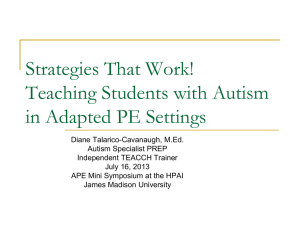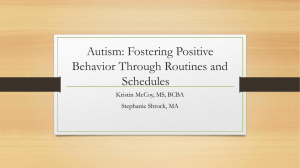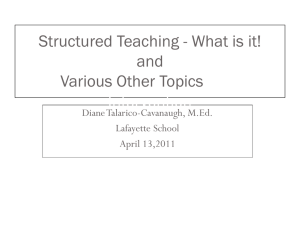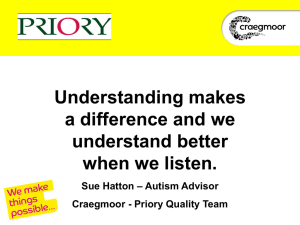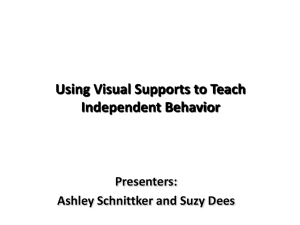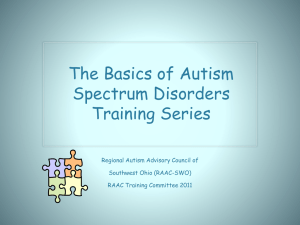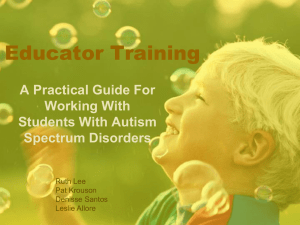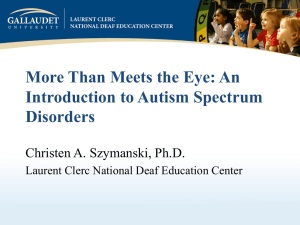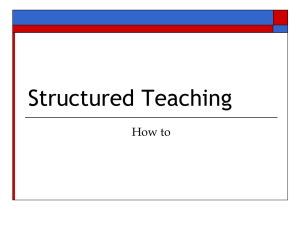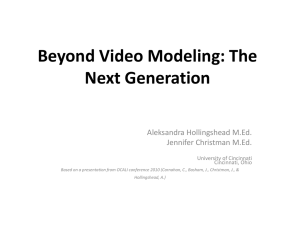Autism: Educational Strategies that Work
advertisement
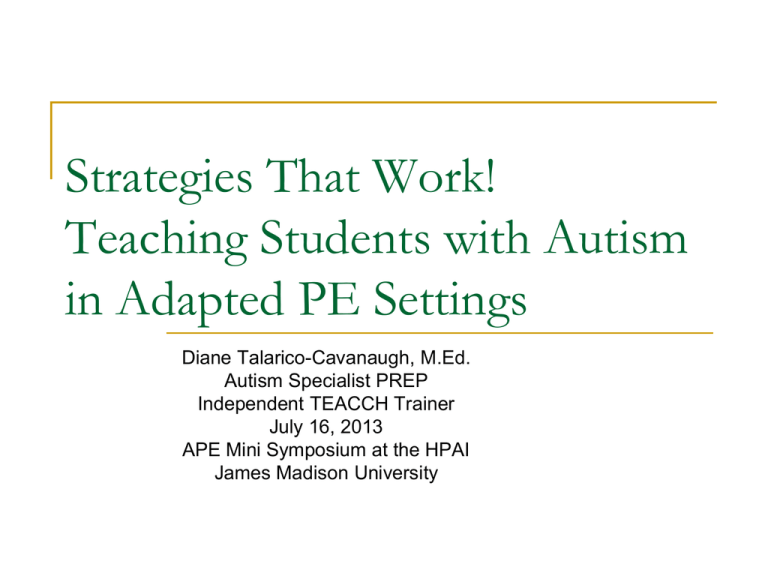
Strategies That Work! Teaching Students with Autism in Adapted PE Settings Diane Talarico-Cavanaugh, M.Ed. Autism Specialist PREP Independent TEACCH Trainer July 16, 2013 APE Mini Symposium at the HPAI James Madison University The Culture of Autism Social Relatedness Communication Sensory Processing Difficulty with Change Cognitive Learning Style Mesibov, Schoppler & Shea Strengths of People on the Autism Spectrum Processing visual information Attention to details or selected areas of interest Sensory perception Simple memory Rule learning Routine oriented Challenges Auditory processing (especially language) Understanding how details fit together, the Big Picture Combining ideas/making inferences Organizing ideas, materials, activities Attention (distractible/shifting attention) Communication (especially social and non-verbal) Concepts of time Attachment to routines and interests Strong sensory preferences and dislikes Executive Function The ability to: Plan Anticipate Organize Predict Inhibit Executive function is the way we monitor and control our thoughts, actions, emotions and behaviors. Which students have Executive Dysfunction For many students, the executive functioning system of their brain is not working properly. Executive Dysfunctions are intimately connected with Asperger's Disorder, Autism, ADHD, some Learning Disabilities and have also been found in adults with OCD. Executive Dysfunctions also effect middle schoolers as part of the developmental process!!!! It is also associated with depression, to name but some of the conditions. Major areas of impairment in Executive Dysfunction Inhibitory Control Cognitive Flexibility Working Memory 7 EXECUTIVE FUNCTION JOBS Inhibition - The ability to stop one's own behavior at the appropriate time, including stopping actions and thoughts. The flip side of inhibition is impulsivity; Shift - The ability to move freely from one situation to another and to think flexibly in order to respond appropriately to the situation. 8 EXECUTIVE FUNCTION JOBS cont Emotional Control - The ability to modulate emotional responses by bringing rational thought to bear on feelings. Initiation - The ability to begin a task or activity and to independently generate ideas, responses, or problem-solving strategies. 9 EXECUTIVE FUNCTION JOBS cont Working memory - The capacity to hold information in mind for the purpose of completing a task. Planning/Organization - The ability to manage current and future- oriented task demands. 10 EXECUTIVE FUNCTION JOBS cont Organization of Materials - The ability to impose order on work, play, and storage spaces. Self-Monitoring - The ability to monitor one's own performance and to measure it against some standard of what is needed or expected. 11 Executive Dysfunction Core Deficits Inhibitory control Cognitive flexibility Working memory Contributing to the ability to Plan Organize Predict Self Monitor 12 13 Addressing Executive Function Challenges Why Use Visual Strategies Visuals are not transient and compensate inattention, poor working memory, inability to prioritize/organize Visuals help sort out or point out what is important Visuals lesson demands on working memory and other executive functions 14 Theory of Mind Theory of mind, or the ability to make inferences about the mental states of other people, is thought to be the primary mechanism underlying our ability to function in complex, collaborative social networks. 15 Theory of Mind (ToM) Broad & multifaceted construct, including ability to understand False beliefs Pretense & Deception Desire & intention Appearance-reality & mental-physical distinctions Affect recognition & causes of emotion Notion that seeing leads to knowing Empathy . . .to understand. . . Visual perspective taking Mental state terms & speech acts Second order thinking (e.g., understanding what Tiffany thinks Patty thinks) 16 Limitations of Traditional Education Methods Use of language: limited ability to attend and process (even students with HF cognitive ability) especially implied, idioms, complex structure and abstract concepts. Use of modeling: not attending to relevant cues, theory of mind challenges Reinforcement: Especially social is not relevant or meaningful. EF affects the link between consequences (Sr+) and behavior. What is Structured Teaching? A specific antecedent based approach designed specifically for students with autism. This approach utilizes the core strengths of the student with autism to facilitate learning. This approach was born out of the T.E.A.C.C.H. philosophy. T.E.A.C.C.H. was founded by the late Eric Schoppler, PhD. in the early 1970’s at UNC. It promotes the “Culture of Autism” as a way of thinking about the characteristic patterns of thinking and behavior of these individuals. Goals of Structured Teaching Promote independence & meaning through structure. Transform curriculum/learning tasks into concrete, visual sequences that compensate for Executive Function Disorder and poor communication skills Structure is not faded or removed but is modified and adjusted Structured Teaching Antecedent based NOT reward or punishment based Uses competence motivation rather than consequence motivation Levels of Structured Teaching: Physical Structure Schedules Work Systems Routines and Strategies Task Physical structure Clearly defined spaces so students can visually see what the expectations are for that area Visual structure that supports the task or activity Answers the questions of why am I here and what do I need to do Physical Structure Physical Structure Physical Structure Schedules Provides a visual (objects, pictures or words) to tell the person what activities will happen and in what order Sometimes it can be faded or changed to match a student’s skills but not eliminated Success does not indicate a lack of need Schedules Routine vs Structure Schedules Schedules Schedules Schedules Work Systems What work? How much do I have to do? How do I know when I am finished? What comes next? Work Systems Work Systems Work Systems Work Systems Work Systems Work Systems Finished Routines and Strategies Visually presented sequence to accomplish a task & address sensory and executive function needs Plan for unexpected, unrewarding, or difficult Uses FIRST-THEN Couples a desired task with a less desired task Social stories Routines and Strategies Routines and Strategies show movement through a sequence Task structure Relies on visual cues and instructions rather than verbal cues Flows left to right or top to bottom Flows from task analysis of skills and sequence Compensates for weaker areas and supports areas of strength Is designed for success and is modified to lead to independence Task Structure Prompting Hierarchies System of Least Prompts (traditional sequence) Independent Verbal Model Physical Structured Teaching Prompts (geared toward learning strengths) Independent MATERIAL(visual) Gesture Verbal Physical Research support for TEACCH model? As a comprehensive program: emerging support Ozonoff & Cathcart, 1998; Panerai, Ferrante, Caputo, & Impellizzeri, 1998; Panerai, Ferrante, & Zingale, 2002 For two of its many components: stronger support Activity schedules: Children/young adults with autism had improved on-task behavior in the absence of adult prompts (Carson, Gast, & Ayres, 2008; MacDuff, Krantz, & McClannahan, 1993; Bryan & Gast, 2000) Structured work systems: Children and young adult with autism had (Hume & Odom, 2007) improved on-task behavior and task completion in absence adult prompts Children with autism showed (Bennett, Reichow, & Wolery, 2011) increased engagement, and speed and accuracy of task completion; decreased stereotypic behavior and escape attempts 44 Conclusions Individuals exhibiting characteristics of autism are assisted by: Using visual work systems to structure their work/activities Bypass skill deficiencies and teach to strengths Counteract problems with executive functioning Build on visual skills Focus attention Need for routine Need for organization Presenting tasks in organized and predictable ways Using visual supports for communication rather than only spoken language
